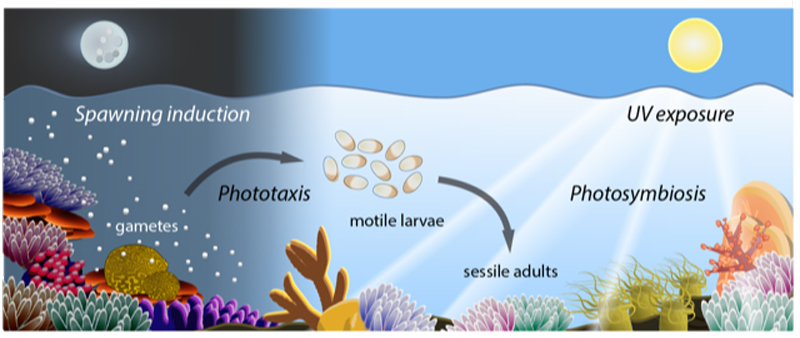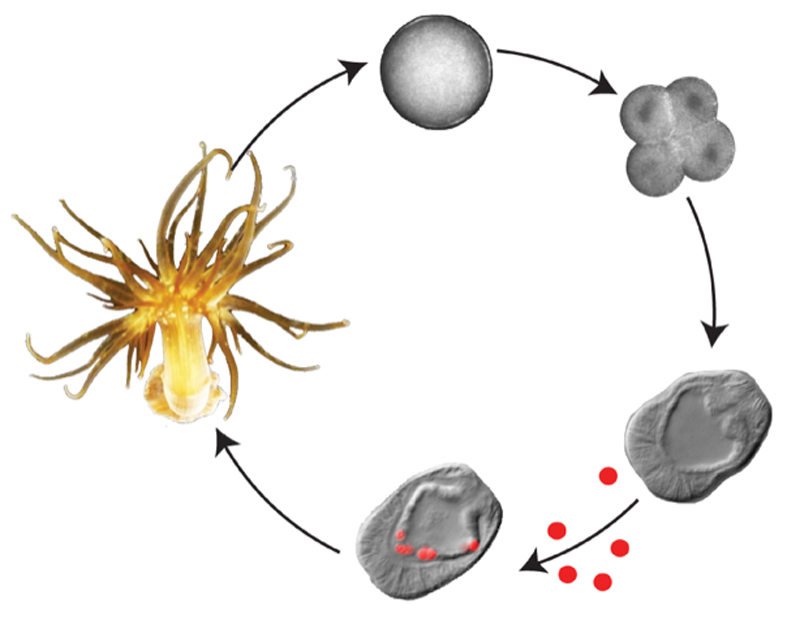刺胞動物の光感知と光応答のしくみを探る
ほとんどの生き物の生活は光によって支配される。太陽光は、光合成や概日時計の制御を含む、様々な生命現象における重要な調節因子として作用している。一方、月の光は、多くの海洋動物の配偶子の同調した放出に重要な役割を果たしている。サンゴやイソギンチャクを含む刺胞動物は、生態学的に非常に重要な水生動物群の基部に分類され、特にサンゴ礁は最も生物多様性に富んだ海洋生態系である。サンゴ礁の生産性は、サンゴ礁を構成するサンゴと光合成を行う共生藻類との機能的な共生に依存しており、貧栄養環境下では共生藻類から宿主のサンゴに炭素固定の供給源となる栄養分を供給する。
本共同研究では、共生性の刺胞動物の光感知の分子機構を解明し、その光感知が刺胞動物の環境適応において、どのように利用されているのかを明らかにすることを目指している。サンゴのモデルとして、ゲノム情報の整備が進みつつあるセイタカイソギンチャク (
Exaiptasia diaphana) を使用し、進化的に保存されている光受容体のオプシンに着目して、その光感知機構の研究を推進する。また、セイタカイソギンチャクでのゲノム編集技術を利用した遺伝子機能解析手法、 または遺伝子サイレンシング技術を確立し、オプシンによる光応答機構の解明を目指す。このように、共生性の刺胞動物がどのように光を感知して有性生殖と行動を同期させるのかを理解することで、その進化と生態についての重要な知見を得ることができ、世界中のサンゴ礁生態系を脅かす気候変動によるサンゴの衰退に立ち向かうための必要な知見を得ることができる。
Light dominates the life of most organisms. Sunlight acts as a key regulator for various functions including photosynthesis and circadian clock control. Moonlight is important for synchronous gamete release in many marine animals. Cnidarians, including corals and anemones are basal, aquatic animals with immense ecological importance. Notably coral reefs are the most biodiverse marine ecosystems. Their productivity depends on a functional symbiosis between reef-building corals and photosynthetic dinoflagellates of the Symbiodiniaceae family, which transfer nutrients to their coral host providing a source of fixed carbon in oligotrophic environments.
In this COS-NIBB joint project, we aim to dissect key molecular mechanisms underlying light sensing in symbiotic cnidarians and how it is used to adapt to the environment. We are using the sea anemone, Aiptasia sp. (
Exaiptasia diaphana) as a model for corals and conduct research to reveal the molecular mechanisms of light sensing focusing on the evolutionary conserved photoreceptor “opsin”. In addition, we will establish a method of gene function analysis using genome editing technology or gene silencing techniques in the sea anemone aiming to elucidate the mechanisms of light response by opsin. Understanding how symbiotic cnidarians perceive light to synchronize sexual reproduction and behavior will provide key insights into its evolution and ecology, a prerequisite to combat the decline of corals through climate change which threatens reef ecosystems worldwide.

Figure 1: Life of corals is dominated by light. (OPTIONAL: Moonlight is used to synchronize gamete release. Motile larvae use light cues to find a suitable location to settle down and start a sessile lifestyle. Sunlight powers the photosynthesis of the corals’ symbionts which provide essential nutrients to their hosts. At the same time, corals need to protect themselves from high UV radiation.) In this project, we will analyze the molecular mechanisms of light-perception in corals to better understand how they adapt to their light-dominated environments.

Figure 2: Aiptasia is tropical marine sea anemone that we use as a model for corals. Aiptasia recapitulates essential light-driven mechanisms including moon-light induced spawning, phototaxis of motile larvae and photosymbiosis with photosynthetic dinoflagellates (depicted in red).







